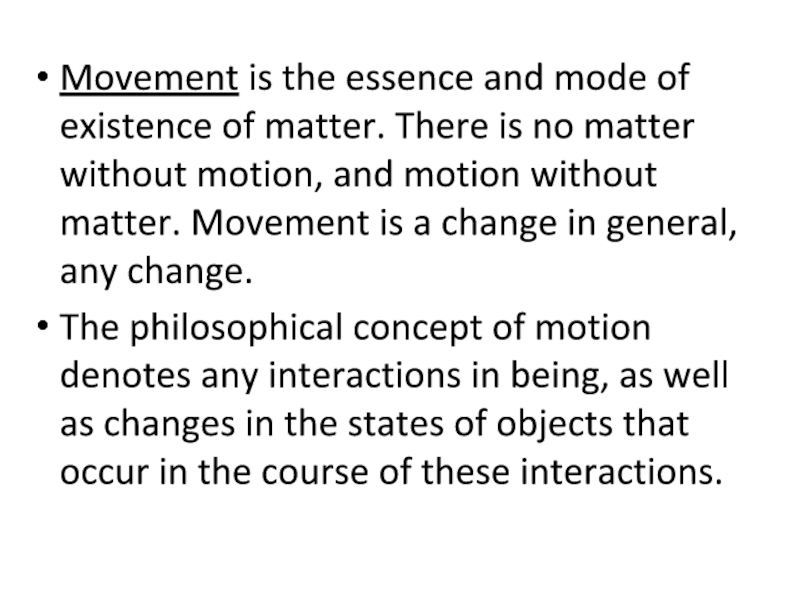Разделы презентаций
- Разное
- Английский язык
- Астрономия
- Алгебра
- Биология
- География
- Геометрия
- Детские презентации
- Информатика
- История
- Литература
- Математика
- Медицина
- Менеджмент
- Музыка
- МХК
- Немецкий язык
- ОБЖ
- Обществознание
- Окружающий мир
- Педагогика
- Русский язык
- Технология
- Физика
- Философия
- Химия
- Шаблоны, картинки для презентаций
- Экология
- Экономика
- Юриспруденция
Lecture № 7. Matter as a philosophical category
Содержание
- 1. Lecture № 7. Matter as a philosophical category
- 2. The main issues of the lecture: 1.
- 3. 1. Matter and its attributes. The philosophical
- 4. In this definition, given by Lenin V.I.,
- 5. Movement is the essence and mode of
- 6. There are 5 forms of motion of
- 7. F. Engels proposed a hierarchical model of
- 8. In science, the view prevails that movement,
- 9. The forms of motion of matter are
- 10. (1). In the inorganic nature: Spatial movement;
- 11. (2). In living nature:Metabolism;Self-regulation, management and reproduction
- 12. (3). In society:Multiple manifestations of people's conscious
- 13. Higher forms of motion of matter historically
- 14. 2. The basic forms of existence of
- 15. Space and time are universal forms of
- 16. Space and time exist objectively, their existence
- 17. A. The substantial concept was
- 18. B. The modern scientific paradigm adheres
- 19. 3. Systemic self-organization of matter. Like movement,
- 20. The irregularity of changes in any one
- 21. 1) Levels of inanimate matter:- Microelement (elementary
- 22. 2) Levels of living matter:Living matter is
- 23. 3) Levels of socially-organized matter: Individual, family,
- 24. Topics for short reports:
- 25. Thank you for attention!
- 26. Скачать презентанцию
The main issues of the lecture: 1. Attributes of matter (space, time, motion)2. Substantial and relational concepts of "space-time"3. Systemic self-organization of matter.
Слайды и текст этой презентации
Слайд 2The main issues of the lecture:
1. Attributes of matter
(space, time, motion)
self-organization of matter.Слайд 31. Matter and its attributes.
The philosophical basis of modern
natural science is materialism, that is, the theory according to
which matter lies at the basis of being.Matter - (from the Latin word materia - substance) is "... a philosophical category for denoting an objective reality that is given to a person in his senses, which is copied, photographed, displayed by our senses, existing independently of them."
Слайд 4In this definition, given by Lenin V.I., matter is affirmed
by objective reality, i.e. not dependent on the person and
his consciousness.Attributes (the attribute means an inherency) of matter, or the universal forms of its being, are movement, space and time that do not exist outside of matter. Similarly, there can not be any material objects that do not possess space-time properties.
Слайд 5Movement is the essence and mode of existence of matter.
There is no matter without motion, and motion without matter.
Movement is a change in general, any change.The philosophical concept of motion denotes any interactions in being, as well as changes in the states of objects that occur in the course of these interactions.
Слайд 6There are 5 forms of motion of matter discovered by
Friedrich Engels:
1) Mechanical (simple mechanical displacement),
2) Physical (movement of elementary
particles, intraatomic and nuclear processes, thermal motion, electromagnetic and optical processes),3) Chemical (chemical reactions, geological processes ),
4) Biological (metabolism, reproduction, heredity, adaptability, growth, natural selection, etc.),
5) Social (material and spiritual life of the individual and society in all manifestations, various public processes).
Слайд 7F. Engels proposed a hierarchical model of being in which
the lower forms of the motion of matter are prerequisites
for the higher. Moreover, the higher forms of the motion of matter are irreducible to the lower forms. Each form of movement of matter corresponds to its material carrier:Слайд 8In science, the view prevails that movement, like matter, had
no beginning and no end. However, if there was no
first-origin movement and no one pushes anything from outside, how can one explain the fact of the movement itself?Philosophy any movement explains as self-movement, i.e. every object is simultaneously the subject of all its changes, its own movement. And the source of this movement is the dialectical struggle of opposites, which constitute the unity of an object or phenomenon, and at the same time they collide and deny each other.
Слайд 9The forms of motion of matter are the main types
of movement and interaction of material objects, expressing their holistic
changes. Each thing is inherent, not one, but a number of forms of material motion. In modern science, three main groups are distinguished, which in turn have many of their specific forms of motion:Слайд 10(1). In the inorganic nature:
Spatial movement;
Movement of elementary
particles and fields - electromagnetic, gravitational, strong and weak interactions,
processes of transformation of elementary particles, etc;Movement and transformation of atoms and molecules, including chemical reactions;
Changes in the structure of macroscopic bodies - thermal processes, changes in aggregate states, sound vibrations, and others;
Geological processes;
Modification of space systems of various sizes: planets, stars, galaxies and their clusters.
Слайд 11(2). In living nature:
Metabolism;
Self-regulation, management and reproduction in biocenoses and
other ecological systems;
Interaction of the entire biosphere with the
Earth's natural systems;Intra-organism biological processes aimed at ensuring the preservation of organisms, maintaining the stability of the internal environment in changing conditions of existence;
Supra-organism processes express relationships between representatives of different species in ecosystems and determine their abundance, area of distribution (areal) and evolution;
Слайд 12(3). In society:
Multiple manifestations of people's conscious activity;
All higher forms
of reflection and purposeful transformation of reality.
Слайд 13Higher forms of motion of matter historically arise on the
basis of relatively lower ones and include them in themselves
in a transformed form. Between them there is unity and mutual influence.But the higher forms of motion are qualitatively different from the lower ones and are not reducible to them.
Disclosure of material relationships is of great importance for understanding the unity of the world, the historical development of matter, for understanding the essence of complex phenomena and for the practical management of them.
Слайд 142. The basic forms of existence of matter.
They are
time and space.
Time is an objectively real form of the
existence of a moving matter, characterizing the sequence of development of material processes, the separation of the different stages of these processes from one another, their duration, their development.Space is a set of relationships that express the coordination of coexisting objects, their location relative to each other and relative magnitude (distance and orientation).
Слайд 15Space and time are universal forms of existence, coordination of
material objects. The universality of these attributes of being consists
in the fact that they are the forms of being of all objects and processes that have been, are and will be in an endless world.Space and time have their own characteristics. The space has three dimensions: length, width and height, and time is only one - a direction from the past through the present to the future.
Слайд 16Space and time exist objectively, their existence is independent of
human consciousness. Each structural level of matter corresponds to a
specific form of space and time, as well as movements.In the history of science two concepts of space and time have developed: substantial and relativistic.
Слайд 17 A. The substantial concept was originally developed by
ancient Greek atomists, and further by Newton. Her supporters believed
that space and time are two separate, independent from each other substances. Space is a container for atoms, time is pure duration, matter is crusty and inert.Слайд 18 B. The modern scientific paradigm adheres to the relational
(relativistic) concept. It was nominated by Aristotle and developed by
Leibniz, Lomonosov, Lobachevsky, Einstein. Under this concept, space, time and matter are interrelated. There is no space outside time and without matter, time without matter and space, and matter outside of space and time.Слайд 193. Systemic self-organization of matter.
Like movement, space, time, systemacy
is a universal, inalienable property of matter. Being a characteristic
feature of material reality, the systematism characterizes the predominance in the world of organization over chaotic changes.The latter are not sharply separated from the formed formations, but are included in them and are subject, ultimately, to the action of electromagnetic, gravitational, other material forces, the action of private and general laws.
Слайд 20The irregularity of changes in any one aspect turns out
to be an ordering in the other.
Organization is inherent in
matter in any of its space-time scales. Structural properties is the internal dissociation of material existence. Levels of organization of matter.
There are three levels of organization of matter:
1) Inorganic or inanimate,
2) Organic or living,
3) Socially organized.
Слайд 211) Levels of inanimate matter:
- Microelement (elementary particles (photons, protons,
neutrinos), each of which has its antiparticle)
- Atomic (atom -
the smallest particle of a chemical element, preserving its properties)- Molecular (the molecule is the smallest particle of a substance that has all its chemical properties)
- Macrolevel and mega-level (planets, planetary systems, stars, galaxies, systems of galaxies).
Слайд 222) Levels of living matter:
Living matter is understood as biological
processes and phenomena. Living matter comes from the inanimate, is
included in it, but represents a qualitatively different level of development.Levels of living matter:
- molecular or pre-cellular (DNA, RNA, proteins)
- cellular
- microorganismic
- tissue
- the organism-population
- biogeocenotic
- biospheric











































